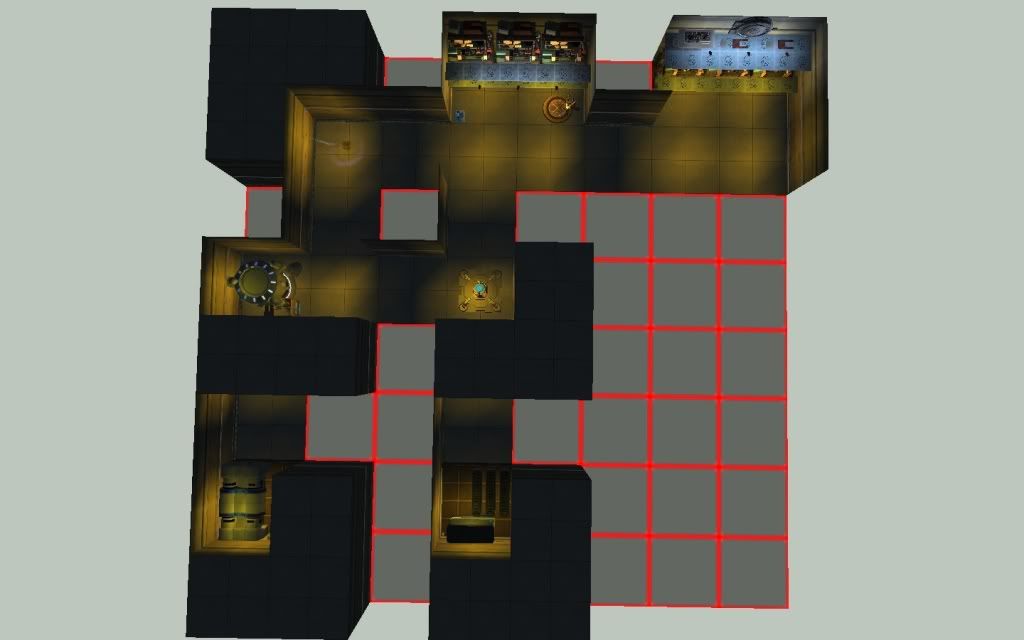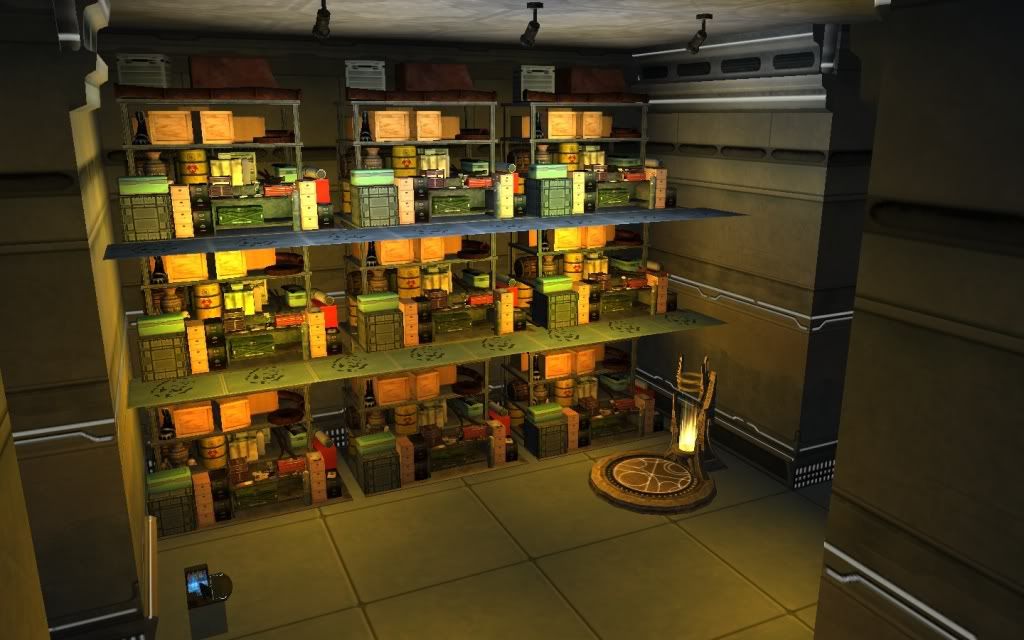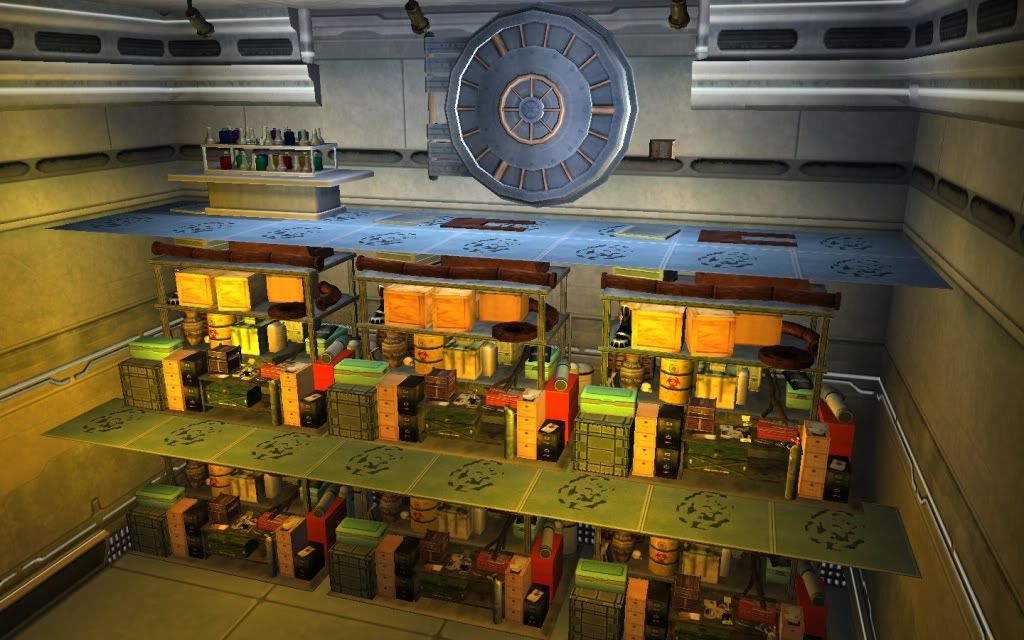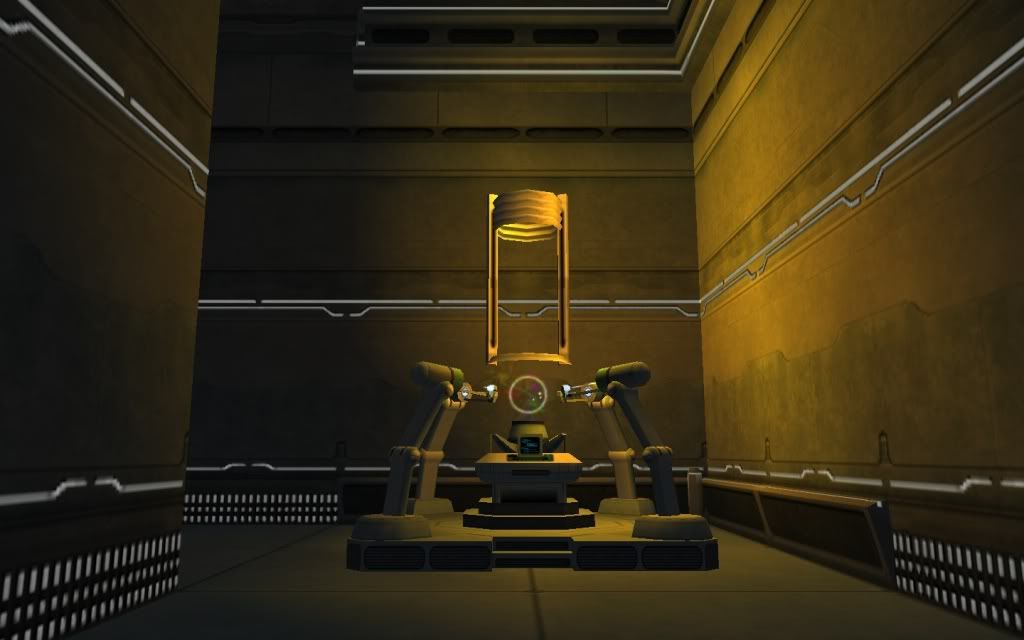A question for base builders; Difficulty of Techniques?
Hopefully the beginner level is when the builder learns about clipping and what a terrible thing it is, both aesthetically and for performance issues in the base. The sooner a new builder learns to spot and hate clipping, the safer the world becomes for puppies and democracy.
I'd describe the intermediate region as placing two items in/on top of each other (like a Sack inside a Wastebasket or a Small Planter inside a Square Altar), basic stacking (one thing on top of another), and basic floating (getting things into the air with Floor Safes/Lamps and Floor Tiles). This is when it becomes useful to get used to thinking of base items in terms of their height, width, and depth (3X4X4 'feet' for a Small Counter, 4X4X4 for a Floor Safe, etc.) and what space is required for a toon to walk through (3 'feet' horizontal, 7 'feet' vertical, steps up at 1 'foot' increments). At this level, the builder can create a usable space.
Advanced is when things start sinking into the ground or other items at specific depths to create specific looks. It involves more detailed work on the illusion that the items created are 'real', exploring new ways to use the tools available to make things the editor does not include (appliances, furniture, arcade games, etc.). This is also where you could go into the use of Cubicles to bring wall items off the wall (Cabinets as walls, Single Power Cable 1 as refrigerator handles, picture hanging, etc.) and stacking 'down' from the ceiling with lights (Fluorescent light stairs, railings, and maneuvering lights into lower-level rooms). At this level, it would also be appropriate to discuss polygon count and how it relates to base lag much more strongly than raw item count (how the pale wood shelves tax the graphics card significantly more than the dark Small Bookshelves because of the extra work required to render each little surface and so forth). At this level, the builder has mastered functional spaces and is working toward beautiful spaces.
My two inf.
my 2 ped:
Start with the basic functions of a base:
The Basics: telepads, telepad becons, storage, buff stations, crafting stations, power, control, plot upgrades, prestige costs and upkeep.
Afterwards I would go for the more advanced techniques like building a lift <stacked safes with floortile> and definitely address the "Z fighting" issue.
I have a base that is nothing but a very well organized warehouse. I'd like to use that as an example. It's meant for storage, crafting, buffing, and telepads. Well, I should say telepad<s> its only one pad with a wall of becons next to it. Will upload pics later today.
Ignoring anyone is a mistake. You might miss something viral to your cause.
I'd say basic would be : plot sizes, room sizes, what goes in which room and the headaches of moving rooms and corridors. Probably some basics on base styles too.
Intermediate would be basic item crafting, moving, and placing. Elementary stacking (no sinking, just the magic desk and such) and interior partitioning (like inner floors) would go there.
Advanced would be high-end stacking, merging, sinking items, combinations of items to create looks and furnitures, and how to play on lighting to hide/enhance base details.
Just how I'd see the course.

basic plot overview, details about functions, costs, items that can be placed.
Power and control: what do they mean? how does that work? how much does it cost?
Edit: this layout was designed with minimal cost, maximum function, fast load time in mind.
Ignoring anyone is a mistake. You might miss something viral to your cause.

In this example, these racks are dedicated for buff station salvage.
Each particular buff has its own rack.
Ignoring anyone is a mistake. You might miss something viral to your cause.

in this example crafting salvage, enhancement table, personal vault.
Nice, neat, organized.
Ignoring anyone is a mistake. You might miss something viral to your cause.

medbay on top of the insp chamber. This gives the player the option of going to base after defeat to rebuff and reload for combat. This has come in handy: returning to combat with 2nd, 3rd tier insp. I would have gone the tree of wonders route. no healing badge yet, plus I found alot of the insp that were 2nd, 3rd tier are better stored and available for use in a pinch.
Ignoring anyone is a mistake. You might miss something viral to your cause.
My advice is all about the functions. Newer players and builders need to know the ins and outs of functional bases. Keep all the functions at the front of the base, and keep all the decorative meeting rooms, chapels, mazes, all of that needs to be- separate from the function.
you don't want people to zone into a base, then have to hunt their way through room after room to find the tp or medbay. You get the idea. Hope this helps.
Ignoring anyone is a mistake. You might miss something viral to your cause.

This might not be for everyone. This is a cost effective tp bay. It requires edit mode every time you need to switch a becon. That could be an issue for larger shared sg's. For a personal sg it's ideal. This example saves on power, control, loadtime and retains high level of function.
Ignoring anyone is a mistake. You might miss something viral to your cause.
THIS!
I loathe when I enter a base and see flicker/clipping. It is a complete eye sore. When people ask me how to "fix" these huge rooms that have flicker everywhere I simply tell them: delete and start over...as it will be less time consuming. Clipping/Flicker to me is the difference between bad and good building skills.
|
Hopefully the beginner level is when the builder learns about clipping and what a terrible thing it is, both aesthetically and for performance issues in the base. The sooner a new builder learns to spot and hate clipping, the safer the world becomes for puppies and democracy.
My two inf. |
My 0.02, for what it's worth. I'm prioritizing a little less on difficulty and a little more on importance for getting things going.
Basic Base Topics:
1 - The Big Picture. Plot and room related rules and limits - namely, how to tell what objects a plot and room can hold, and how many of them (main control/energy and storage items can be limited by either room or plot size). That what items show up to place in a room depend on if it can even take items of that category at all. Also, things about where can rooms go, where doors can go, base continuity, blocked doors, etc, and related techniques (like how you can put things in front of a door that already exists, but can't put a door behind things that are already there).
In short, first cover, "why is this red or not even showing up as an option for me."
2 - Basic functional items. Understanding energy and control. Understanding crafting and placing crafted items (add from personal base items, move in normal edit mode). Note that items placed from the personal item list have to be deleted out of a room individually before the room can be blanket-deleted. Note that some base items are yielded from sg badges. Zoom in on how to set up teleporters and how to set up a workshop for storage and crafting.
3 - Rent, rent payment, rent overdue behaviors. SG settings that affect bases, such as entry and edit permissions.
4 - Basic aesthetics. Introduce 'room style,' 'room color,' 'room topography/shape,' and 'room lighting' controls. Warn people about using 'apply to base' except on a fresh base! Point out that clipping and texture flicker is to be avoided.
5 - Basic 'avatar ergonomics' - leaving room for characters to move through, putting functional items in accessible locations, etcetera.
By the time they finish with the basics I think the reader should be able to set up a functional base and furnish it to their liking, without driving themselves nuts trying to get to their stuff, and keep its rent up and maintain it over time.
Intermediate techniques and issues would be performance and cosmetic ones.
1 - Warn about the 'high-object base data corruption bug.' Warn about the performance effects of lights, especially high-particle count lights like torches and bonfires, on PC performance, up to and including making bases un-enterable for some players (I've heard of several bases with so many torches, players crash trying to enter them and simply can't get in). Note that rendering in general in bases isn't well optimized and larger bases will consistently have poorer performance - for performance, less is more.
2 - Stacking/floating up from the floor. Cover stacking with desks, safes, and lamps and using the floor tile. Cover building platforms/second floors.
3 - Placing wall-mount items without a wall using the cubicle.
4 - Different methods of building walls using stacking. Mention SG glass logo windows.
5 - "Merging" discrete items to make "composite" objects and complex furniture/equipment. Good place to put in example furnishings.
6 - Specific room style options that have environment simulation uses or work well at something - like green miyuki gravel for grass and blue for water.
7 - Overall map design. Where to put what rooms (such as teleports and workshops near the entrance for convenience).
Advanced:
1 - Stacking ceiling items down from the ceiling.
2 - Sinking things into floors (and doing so at varying depths).
3 - SG logo and color interactions with "SG items" like glass logos and floor plates.
4 - Large/complicated merged objects, like simulated vehicles, vending machines or so forth.
5 - Interesting full-base themes - mazes, space stations, forests, etc.
"Experience is the mother of good judgement. Bad judgement is the father of experience."

Hello base builders!
So, I get asked often to advise on base building things and it got me thinking that I should create some sort of guide for the things I create most often as a stepping stone for new(er) base builders. I'm currently considering making some video tutorials on how to make some nifty little base details (how to make a good looking kitchen/bedroom/meeting room etc etc) For these videos I was thinking of making beginners, intermediate and advanced technique sections so people can attempt what they feel most comfortable with.
My problem is I've been doing things for so long that I need advice on what people would consider each grade of difficulty!
Obviously beginners techniques would be basic arrangement, no stacking or sinking items into other items, but what about intermediate and advanced? What would you consider the 'step up' from basic and what would you consider trickier than that?
Any help would be great!
((Metafanzine Published by @Chaos Bunny))
Unionverse Page | Virtueverse Page